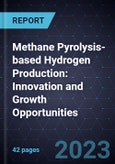Methane Pyrolysis is Advancing the Hydrogen Economy through Cost-effective and Low-emission Hydrogen Production
The shift to a low-carbon, hydrogen-based economy is prompting the energy industry to explore more cost-effective and sustainable technologies, including methane pyrolysis (turquoise hydrogen), which offers significantly lower carbon emissions than steam methane reforming (SMR) and provides a more economical alternative to existing electrolysis-based green hydrogen production. Methane pyrolysis's cost-effectiveness can be further enhanced through the effective utilization of the solid carbon byproduct, which none of the other competing technologies produce.
The solid carbon produced has potential applications across diverse sectors, such as electronics, energy storage systems, tire production, agricultural additives, and construction materials. Currently, emerging companies are at the forefront of methane pyrolysis research, development, and commercialization. Research encompasses thermal, thermocatalytic, and plasma decomposition methods for methane cracking, with each method offering unique advantages.
This study opens by offering a comparative analysis of methane pyrolysis with conventional hydrogen production technologies (SMR and water electrolysis). It covers multiple aspects of hydrogen production through methane pyrolysis, providing an overview of the thermal, thermocatalytic, and plasma pyrolysis processes.
The study evaluates each method's strengths and challenges and highlights the pioneering companies in each segment. In addition, it offers insight into the technology's driving forces and challenges and provides a techno-economic analysis of the various processes associated with methane pyrolysis. It also covers the patent landscape and offers a comprehensive analysis of the growth opportunities projected to play a pivotal role in driving the adoption of methane pyrolysis technology.








